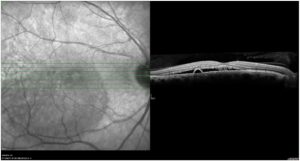Central Serous Chorioretinopathy (CSCR) is characterized by the accumulation of a blister of fluid under the central retina or the macula. Patients experience symptoms of blurring of central vision in one eye and occasionally minification of the image seen compared with the other eye.The exact cause of central serous chorioretinopathy is not known, but several theories exist as to the underlying cause. One theory is that the Retinal Pigment Epithelium which is a single layer of cells under the retina becomes leaky allowing fluid to accumulate under the retina. Another theory, is that the choroid, which is the vascular coat external to the retinal pigment epithelium becomes congested resulting in fluid exudation into the space under the retina. Central Serous Chorioretinopathy occurs more commonly in males between the age of 25 – 45.
Optical Coherence Tomography scan showing fluid accumulating under the retina in CSCR. There is also a small localised detachment of the retinal pigment epithelium present (Pigment epithelial detachment or PED)
Treatment
In most cases of CSCR, the fluid under the retina reabsorbs spontaneously with a resultant clearing of the vision. The patient may however have persistent symptoms of minification of the image, distortion, reduced contrast sensitivity and the sensation that colours are washed out when looking through the affected eye.
In cases whereby the fluid does not resolve spontaneously, a fluorescein angiogram to identify the site of leakage may be performed. If a leaking spot can be identified on fluorescein angiography, it may be possible to treat this leaky spot either with laser. Either a warm (thermal photocoagulation) or a cold laser (photodynamic therapy) may be used depending on how close the leaking spot is to the direct centre of the retina.

